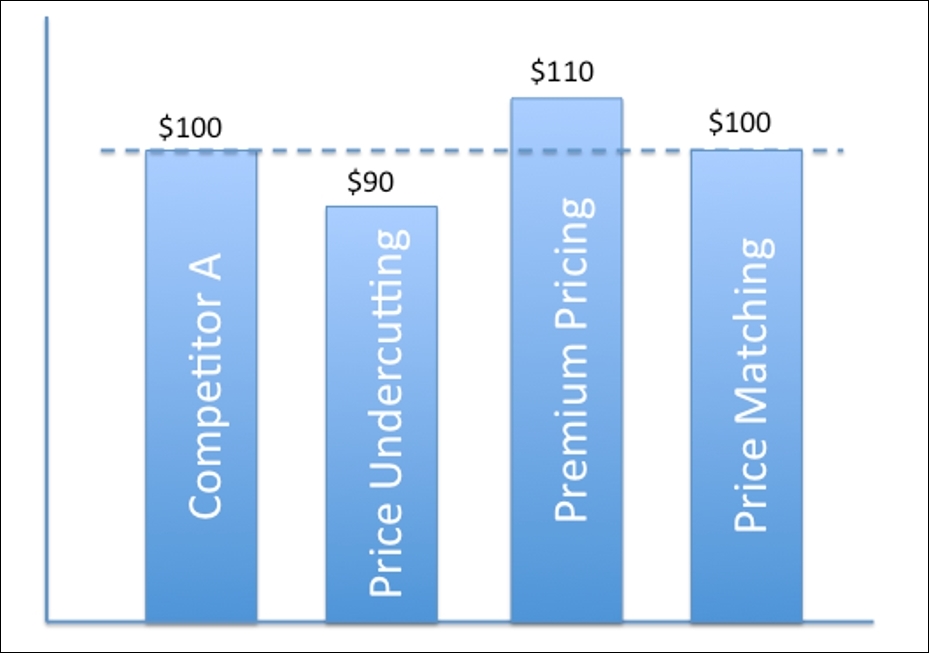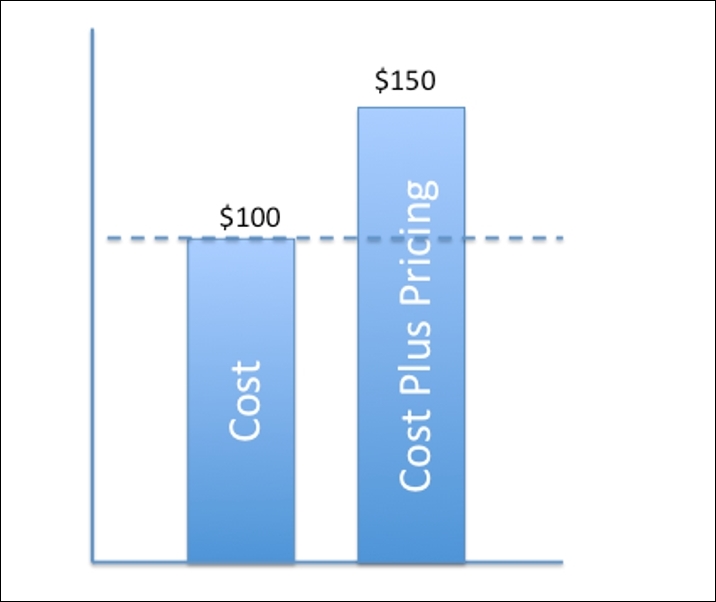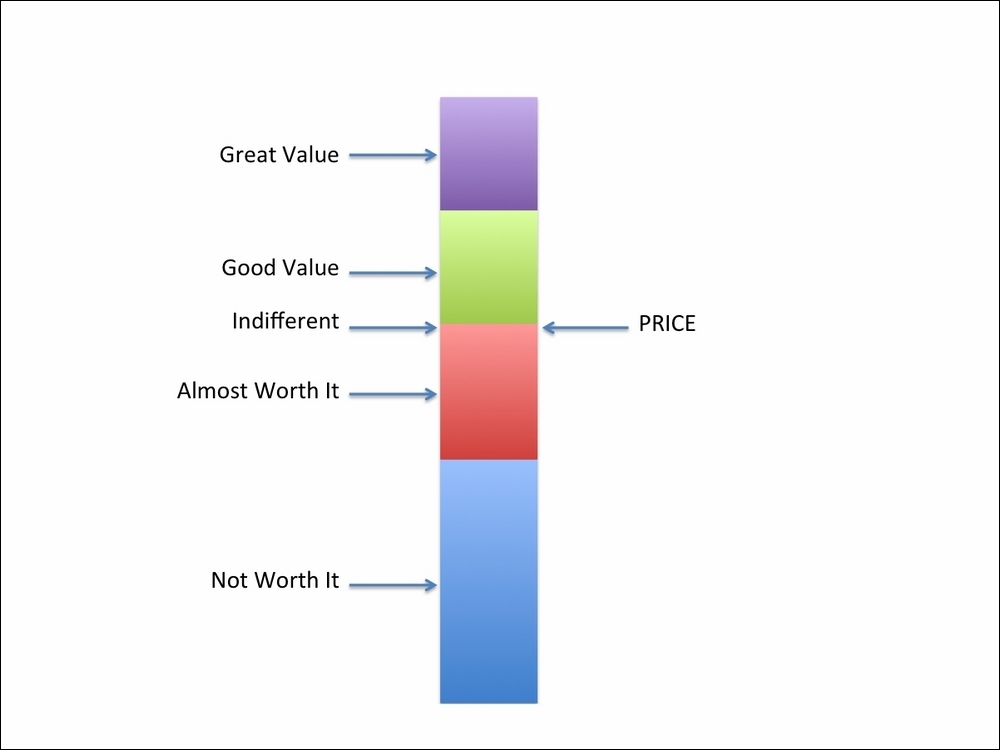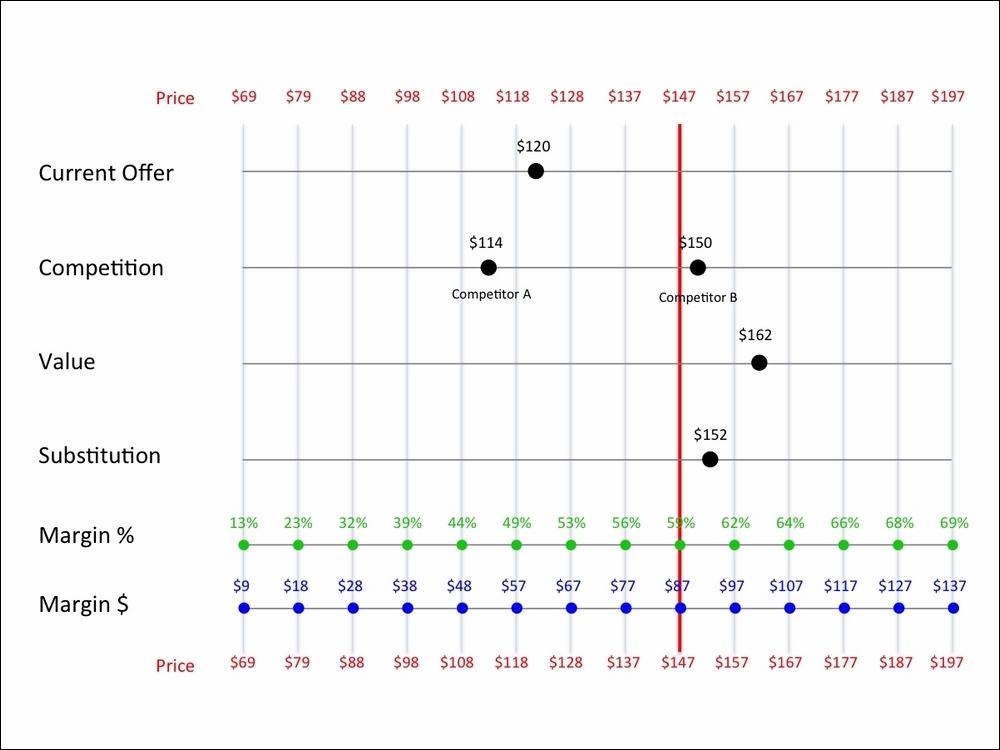Once you have completed the QFD and you have agreed which design characteristics your product will have and when, you must begin the analysis of determining how to price your new offering. Setting the correct price for your offering is critical to a product developed through VoC. Set the price too high, and the sales team will have difficulty closing sales, your revenue targets will not be met, or the customers will not purchase your offering at all. Set the price too low, and you will leave margin behind, or even worse, operate at a loss. Price ends up being the number one factor that dictates whether your offering will succeed or fail in the marketplace. While this is not a book on pricing, it is my desire that you will begin to understand how customer VoC can drive pricing decisions, and as a result, you will incorporate value questions into your VoC research.
When setting price, you need to look for the best, or what could be considered the optimal price, to maximize your profitability. That does not mean that you are looking for the highest price possible to sell your offering. Neither does it mean that you should be evaluating your costs to build your product and then, using cost-based pricing, merely adding an arbitrary percentage above the cost to derive the price. Also, it does not mean analyzing what your competitor charges and matching their price, although that can be a valuable data point.
Unfortunately, this is often how marketers go about pricing their products. The following two illustrations show the most common pricing methods:

Figure 9.17: Competition-based pricing
In the first example, the price is derived from what the competitor(s) is (are) charging. One tactic would be to slightly undercut your competitor, particularly if they had a better market presence than you. In the other case, you might actually charge a slight premium if you have higher brand equity than your competitor. Or you might just match the competitor's price in an effort to be another alternative, without having to defend why you are charging more than the competition, or charging less and potentially leaving money on the table:

Figure 9.18: Cost-based pricing
In the second example, the price is set based on the cost to manufacture or deliver the product in what is known as cost-based pricing. In these cases, marketers analyze the cost of the product, and then add a fixed amount to meet the margin goals of the business or corporation.
While some might argue that the first approach may be considered market-based pricing as your pricing is determined by what the competitors are charging, neither of these examples can be regarded as value-based pricing.
Simply put, the most optimal pricing strategy is one based on value, and not purely competition or costs. Only by understanding the value your product brings to the customer can you truly price effectively. This is why a good customer VoC is so essential for the pricing process.
If you have done your VoC correctly, you probably have a pretty good idea of the pains that the customers have when using your competitor's or your products. You probably also understand the benefits that the products they are currently using provide to them. While you may not think to try and quantify value when you first put together your customer questionnaire, you will find that if you do, the pricing exercise becomes much, much easier.
When discussing value in the context of pricing, it is good to try and remember that there are two ways to look at value created or received. One is to look at it from the eyes of the company. From the company's perspective, there is internal value creation from the cost of the product to the selling price. Additional value is created, and is typically passed to the customer as shown in Figure 9.19:

Figure 9.19: Value creation from the company's perspective
Of course, the customer rarely knows much, if anything, about your cost – they only see the price. So, their perspective about how much value is created is totally dependent on the amount of benefit they believe they will receive versus the price they will have to pay. As Warren Buffett once said, "Price is what you pay. Value is what you get."
If their expected benefit falls anywhere below the price point, they will conclude that your product is not worth it. But once the value rises above the price point, they will deem that your product is clearly worth it, and could be considered a real bargain if that point is significantly above your price point:

Figure 9.20: Value creation from the customer perspective
When looking to determine a pricing strategy based on value for your offering, it is also an important consideration to remember that the maximum price that you can charge for your product is the cost of the next best alternative, plus the incremental value your product or offering creates.
Looking at it on a formulaic basis:
Maximum Price = Price of next best alternative + value your offering creates - value the next best alternative creates
You can see that if you do not understand the value your offering creates and the value the competitive products create, you limit your ability to set a price that returns the maximum financial results to your organization. Of course, placing your product at the maximum price does not guarantee you will get the sale. It only ensures that you are priced at relative parity with your competition. If you wish to increase your chances over the competition, you need to determine both the maximum price as well as the optimum price.
Then the question becomes, "How do I set my optimum price?" To do so, you must have a much deeper understanding of the customer and what the customer values. If the customer values reducing installed cost of your type of product, you would need to know how much savings you can provide to the customer through reduction of procured price, as well as reduction in hours to install. As you can see, using the information we have gleaned in the VoC sessions can go far in helping us to set our optimum price and extract as much value (revenue) in return from the customer's engagement.
Your optimal price will maximize your revenue, while providing your customers with more "value" over the total life of the product. In essence, we need to understand both the value (the benefits your product brings) as well as the total cost of ownership for your product versus the rest of the market. To begin to gain insight into these areas, start by asking these questions:
- How differentiated is your offering?
- How sustainable is that differentiation?
- How much value does this differentiation deliver to customers?
- How would the customer describe the value your product brings? At a minimum, can they describe the value on the differentiation your product brings?
- How would they equate that value, or the value of the differentiation, to a monetary figure?
- What is the best pricing method to capture value (initial purchase price, price and maintenance, subscription, and many more)?
- What are your competitors likely to do relative to various price points? Will they try and undercut your price? Will they opt for premium pricing?
- Does the customer have the necessary capital available to purchase your offering?
- Do you have the ability to charge different price points to the differing market segments you serve?
You will probably not receive clear and consistent feedback from these questions that will drive you to an exact number. You will, however, develop more insights into the value of your product, and you can use this as well as the price of the competition and your costs to help drive to an optimal price.
Again, I would caution you against using cost-based pricing. In my experience, cost-based pricing leads to one of two things. Either you end up leaving money on the table that you did not need to, or you end up trying to compete in an industry where you do not have the cost structure or processes to be successful. In the first, you shortchange yourself. In the second, not enough customers buy your goods or services and you either exit the market, or you are pushed to fire-sale your products to meet the market price at a lower-than-optimal margin level. Better you know what the market price is before entering the market and investing your capital.
If you are able to set an optimum price for your products, you are better able to arm your sales team with the necessary sales collateral and differentiation story, so as to prove the incremental value to your customers and extract maximum revenue.
I believe it is often helpful to try and plot a number of the various considerations that go into your pricing analysis into a simple chart. Following is such a chart I have used in the past to help me visualize where various pricing levels would place my product with respect to customer value, gross margin targets, competition, and many more.
In Figure 9.21 you can see I have plotted my current products price, a number of competitive products and their prices, the "value" price I could set based on my customer feedback for differing functionality, and the price for a customer to use a substitute product that is not a direct competitive product. The substitute product might even be a product you provide that the customer is attempting to force into his current application (see Chapter 3, Laying the Groundwork for a discussion on substitute products), as well as margin % and margin $ at the various pricing points. While it is not advisable to use cost-plus pricing, it is imperative you understand your Margin $ and Margin % for your proposed product and pricing levels before you engage with your senior management:

Figure 9.21: Pricing analysis
In the example shown in Figure 9.21, you will see that I have plotted a current product we are selling at $120 plus two competitive offerings as well as a substitute product, which has a higher price than the current products in the market. Based on the VoC we have done, we determined that the new product we will release provides $162 worth of benefits to our customers. In this example, if I were to choose a price for our new offering, I might select a price of $147. This would allow me to pass on $15 of incremental value to the customer ($162 - $147), while slightly undercutting competitor B. As a double-check, I can also see that this pricing level would deliver a 59% gross margin and $87 margin to the business for every unit sold. If this meets the internal hurdles for a new product, this may be a good price for our new product.
